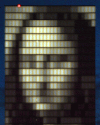Toshiba unveils Linux-based home entertainment gateway platform
September 30, 2002San Jose, CA — (press release excerpt) — Toshiba America Electronic Components, Inc. (TAEC) today disclosed details of a complete integrated TX49 Reduced Instruction Set Computer (RISC) processor-based reference platform for entertainment home gateway applications. Five leading companies joined with TAEC and cooperated in the development of the reference platform: Lineo, Systemonic, Sigma Designs, Vweb,… (more…)
 Project Blinkenlights has transformed the Bibliothèque nationale de France (in Paris) into what is claimed to be the world's largest computer screen. The 520 pixel display, called Arcade, consists of a matrix of 20 x 26 of the building's windows — resulting in a giant computer screen having an area…
Project Blinkenlights has transformed the Bibliothèque nationale de France (in Paris) into what is claimed to be the world's largest computer screen. The 520 pixel display, called Arcade, consists of a matrix of 20 x 26 of the building's windows — resulting in a giant computer screen having an area…